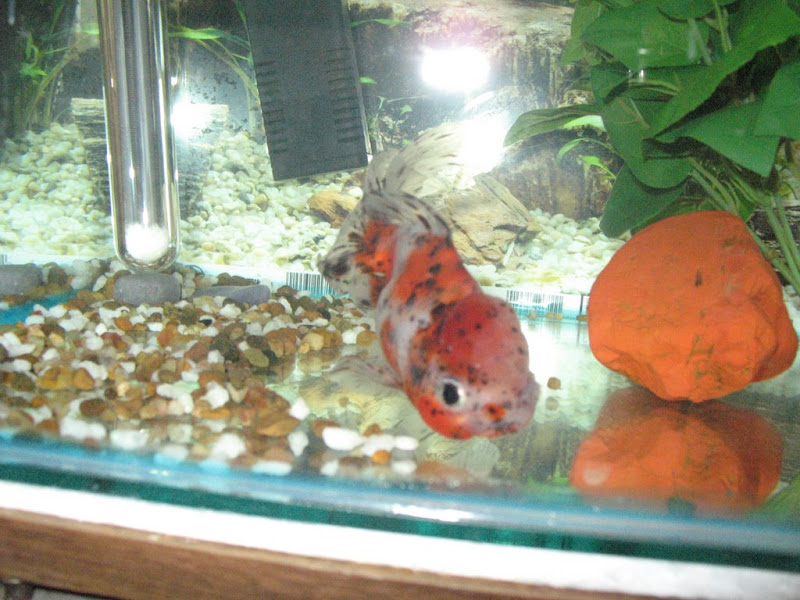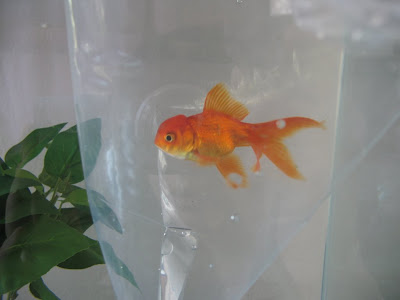This post will be used to document Franny's quarantine process. The plan is to quarantine her for 30 days to observe for any illness. Days flow from newest to oldest.
Acronyms used: NH3 = ammonia, NO2 = nitrIte, NO4 = nitrAte, QT = quarantine tank, WC = water change.
Day 22, 29 July 2008Made a conscious decision to move Franny from quarantine and into the main tank. This is 8 days short of her intended schedule, i know, but the water parameters are not looking good, even with frequent water changes. B.T.W a high ammonia level is far more dangerous to a fish than any parasite! So there, decision made!
Day 21, 28 July 2008Tank Stats
NH3 = 0.5, NO2 = 1
NO4 = 10
20% WC
Keeping those water changes up is all i can do at this stage.
Day 20, 27 July 2008Tank Stats
NH3 = 0.5, NO2 = 1
20% WC
Eek! NO2 at 1ppm - that's not good, so i promptly did a water change and added 1tsp of salt /gallon to the tank. Looks like the bio-media in the corner tank is taking a while to catch up.
Tip of the day: once your bio-media is on track and your tank is established, don't go poking around too much! The tank will mini-cycle every time. Don't fix what's not broken :(Day 16, 23 July 2008Tank Stats
pH = 7.8, NH3 = 0.25
NO2 = 0.25, NO4 = 10
20% WC
Tank stats on the rise again. No doubt due to the fact that the filter wool was replaced in the main filter. I thought it would be ok considering i have a suspending stocking with gravel hanging over the filter and the corner filter has filter wool in as well. Guess you need all the bugs you can get!
To combat NitrIte build-up, i added 7tsps salt. Another dose of Prazi was also added today to keep up with the scedule.
Dosing Schedule: Day 14 - normal partial water change, then add prazi.
Interesting Observation: the tank is going through some cloudy water stage. This is due to a bacterial bloom (which explains the rise in NH3 and NO2). Once the bio-bugs catch up, the water should clear again. A series of water changes can be performed to help with both the bacterial bloom and the cloudiness, if your tank stats increase.Day 10, 17 July 2008Tank Stats
pH = 7.8, NH3 = 0.1
NO2 = 0, NO4 = 10
20% WC
Dosing Schedule: Day 8 -- normal partial water change with vacuuming
A normal partial water change with vacuuming was carried out today. Tank stats looking good. I replaced the filter wool in the main filter as it was very dirty.
Day 9, 16 July 2008Added another dose of Prazi. Dosing schedule so far as follows:
Day 1 -- remove carbon, perform water change with vacuuming, and add Prazi to tank
Day 2 -- add Prazi
Day 3 -- do nothing
Day 4 -- do nothing
Day 5 -- do nothing
Day 6 -- add Prazi
Day 7 -- add Prazi
Day 5-6, 12-13 July 2008Tank Stats
NH3 = 0, NO2 = 0
NO4 = 10
6% WC
Things are going well, cycling is on track again. The 6% WC keeps the water clean from poop, don't want ammonia building up in such a small tank! I added 1tsp of salt back to the 4.5 liters that was taken out.
Day 8, 15 July 2008Tank Stats
Temp 24.5C or 76F
After waiting 3 days, another dose of Prazi was added to the tank. Did not check tank stats today.
Day 4, 11 July 2008Tank Stats
NH3 = 0.1, NO2 = 0.25
Added 2nd dose of Prazi today - 1.1ml + 9 tsps salt, which brings the salt treatment to 0.3%. Franny's dorsal fin was flying high today! She ate well - Kiwi for lunch and 4 pellets for supper.
I also started the 1st dose of Prazi in my main tank, since Vinni and Gabby have not been treated for parasites either. Prazi does not affect your bio-filter, so it is safe to use. The only downside is i had to remove the carbon from the tank.
Day 3, 10 July 2008Tank Stats
NH3 = 0.25, NO2 = 0.25
20% WC
Salt treatment = 5tsps salt (2tsps didn't dissolve properly, so will add that tomorrow). Also, with every WC i top up the salt treatment, i.e. if i remove 4.5 liters of water, i add back 1 tsp salt.
Franny didn't seem as active today as yesterday, however she ate well. Fed her 1.5 peas for breakfast, a thin cucumber slice for lunch, and 2 pellets for supper.
Noticed an interesting thing this evening - she pooped out little green pieces of pea - clearly not broken down or absorbed properly. This is usually an indication of a digestive problem caused by intestinal parasites or worms. Treatment = Tremazol or Droncit which contains praziquantel which is exactly what i want to treat her with in the first place.
Tip: always examine your fish poop - as with humans, its a good indication of overall health.I decided to treat with Tremazol (made by Sera) straight away, by following the
Praziquantel instructions on my forum, rather than the pamphlet.
Prazi Treatment, Step 1: remove carbon, perform water change with vacuuming, and add Prazi (2.5 milligrams per liter of water) to tank. For me this works out to 1.1mg in my 32 liter tank.
How i measured: the composition on the bottle says for every 100ml, it contains 7.47g prazi. So, 1ml/100ml x 7.47g = 0.0747g x 1000 (converting from grammes to mg) = 74.7mg. Then, because i need 2.5mg per liter of water, which works out to 80mg (32 x 2.5), i then do my final calculation: 80mg / 74.7 = 1.07ml of prazi to add to the QT. Phew!
Final note: Franny's dorsal fin is a bit down tonight, not much, just a little, hope the worm treatment will help.
Day 2, 9 July 2008Tank Stats
pH = 7.8, NH3 = 0.25
NO2 = 0.1, NO4 = 10
20% WC
Clearly the ammonia and nitrIte is increasing again - Franny is double the size Gabby is, so the filter media will need time to adjust to the new "load". With that in mind i want to make sure to only feed veggies and to limit the amount of food given until the bio-media catches up. After doing a water change i added a 0.1% solution (1 teaspoon of salt per gallon (4.5 liters)) of salt, dissolved in tank water. The idea is to increase the salt concentration to 0.3% (3 teaspoons of salt per gallon) over 3 days, and then keeping the salt level up for at least 7 days.
Tip: this reduces and eliminates some parasites.Franny nibbled on my hand during the entire WC process, she's just the cutest, friendliest fishy by far! I gave her 1.5 peas for breakfast, but felt sorry for her during mid afternoon when i was feeding the other guys, she seemed to stare at me and them like she knew they were being fed and she wasn't. Felt so sorry for her that i gave her a tiny piece of the shrimp *blush*. She seems even more active today than yesterday!
Day 1, 8 July 2008 - The ArrivalTank Stats
pH = 7.8, NH3 = 0
NO2 = 0, NO4 = 10
After arriving home with Franny, i emptied the bag with water into my 8L plastic container. To acclimatise her to my water parameters without inducing severe shock to her immune system, i connected a piece of plastic tubing from my quarantine tank to the plastic container, and allowed the water from QT to slowly drip into the container. After the water in the container tripled, i scooped her out gently with my (
clean) hands and placed her in QT.
Tip: this method equalizes all water conditions, including temperature, between the aquarium and shop water.She started swimming around straight away. I let her be and after a couple of hours fed her 4 Hikari Lionhead sinking pellets. She ate with vigor! After another couple of hours i did not notice any pooping, i then suspected she might be constipated, so i fed her a defrosted raw pea. She seems very active and alert, no signs of bottom-sitting, floating or sinking.









 She's currently in my quarantine tank just to make sure she's not carrying any parasites or anything.
She's currently in my quarantine tank just to make sure she's not carrying any parasites or anything.